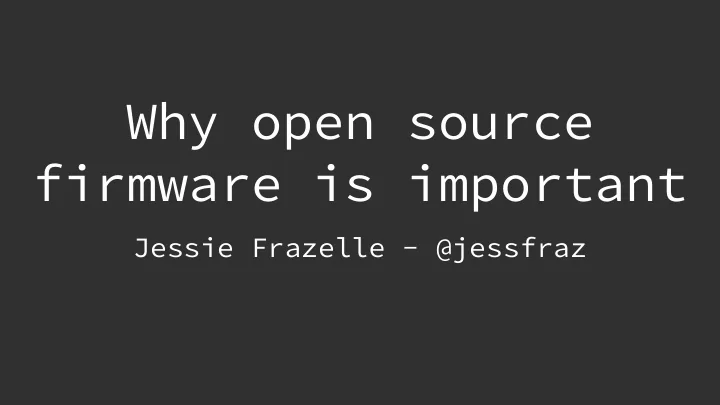

Why open source firmware is important Jessie Frazelle - @jessfraz
Points of View 1. Security 2. Usability 3. Visibility
First Point of View: Security...
Software Software Operating System Kernel Firmware Hardware
Software Software Software Software Hardware
💪 Software 💪 Software 💪 Software 💪 Software 💪 Hardware
Ring 3: User space Ring 0: Kernel Ring -1: Hypervisor Ring -2: SMM, UEFI kernel Ring -3: Management Engine
The code we don’t know about... Ring -2: SMM, UEFI kernel Ring -3: Management Engine
System Management Mode - Originally used for power management - System hardware control - Proprietary designed code - Place where vendors add new features - Handle system events like memory or chipset errors - ½ kernel Ring -2: SMM, UEFI kernel
UEFI Kernel - Extremely complex - Millions of lines of code - UEFI applications are active after boot - Security from obscurity - A bajillion features, extremely complex Ring -2: SMM, UEFI kernel
Management Engine - Networking management - KVM management - Intel proprietary features - Can reimage your device even if it’s powered off - Can turn on node invisibly - Minux - SO MUCH MORE Ring -3: Management Engine
That’s just one example of a bad attack but if you google you can easily find others...
This is bad.
It gets even worse.
Intel Boot Guard
Adds up to: 2½ other kernels/OSes… - They each have their own networking stacks, web servers (wtf) - The code can modify itself and persist across power cycles and reinstalls Ring -2: SMM, UEFI kernel Ring -3: Management Engine
Adds up to: 2½ other kernels/OSes… - They are all incredibly and unnecessarily complex - THEY ALL HAVE EXPLOITS! Ring -2: SMM, UEFI kernel Ring -3: Management Engine
Second Point of View: Usability...
The results
29.2% Mentioned Firmware as a Pain Point
So at what scale is firmware a pain?
My hypothesis...
Once you need to deal with the firmware it becomes a pain...
Third Point of View: Visibility...
Conway’s Law
From the perspective of hardware engineers...
“You’d be crazy to think hardware was ever intended to be used for isolating multiple users safely..”
Spectre and Meltdown proved this to be true as well.
From the perspective of firmware and kernel engineers…
They want vendors to make their firmware do less, or give up the control to them.
Vendors can rarely debug firmware issues…
Oversights and lack of communication leads to...
How did no one think about the BMC when building softlayer?
I’ve personally seen these miscommunications happen in the container ecosystem as well...
Miscommunications at various layers of the stack lead to bugs in the intersecting layers, based off incorrect assumptions.
💪 Software 💪 Software 💪 Software 💪 Software 💪 Hardware
How do we fix these things? 1. Security 2. Usability 3. Visibility
Open Source Firmware
NERF : Non-Extensible Reduced Firmware
NERF Goals - Make firmware less capable of doing harm - Make its actions more visible - Remove all runtime components - With ME we can’t remove all but we can take away the web server and IP stack - Remove UEFI IP stack and other drivers - Remove ME/UEFI self-reflash capability - Let linux manage flash updates
Ring 3: User space Ring 0: Kernel Ring -1: Hypervisor Ring -2: SMM, UEFI kernel Ring -3: Management Engine
Ring 3: User space Ring 0: Kernel Ring -1: Hypervisor Ring -2: SMM, UEFI kernel Ring -3: Management Engine
Ring -1: Hypervisor Ring -2: SMM disabled Reduced UEFI ROM Linux kernel and Minimal userland Ring -3: Minimized Management Engine
linuxboot device drivers, network stack, multi-user/tasking u-boot or coreboot environment silicon and DRAM initialization u-root userspace tools and bootloader, initramfs
Why linux? - Single kernel works for several boards - Already quite vetted and has a lot of eyes on it since it is used quite extensively - Single, open source kernel versus the 2½ other kernels that were all different and most closed off - Improves boot reliability by replacing lightly-tested firmware drivers with hardened Linux drivers.
Other wins - Firmware devs can build in tools they already know - When they need to write logic for signature verification, disk decryption, etc it’s in a language that is modern, easily auditable, maintainable, and readable - Memory safety wins as well since the language can be higher level
Makes boot time 20x faster.
Through open source, visibility, minimalism, and open communication we can push computing to a better, more secure place from the hardware up.
We can’t keep building on top of 💪 . We really need to care about the base we build on.
Huge thanks to the firmware community for all their work on this!
Ron Minnich Trammel Hudson Chris Koch Rick Altherr Zaolin
Thanks for having me!
Recommend
More recommend